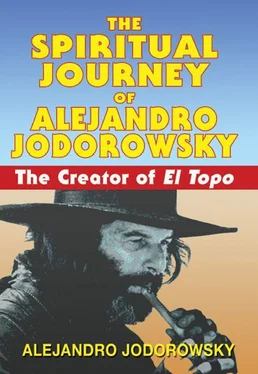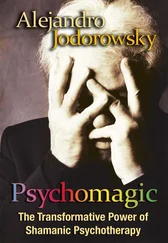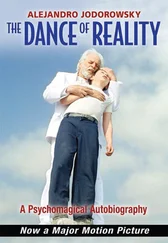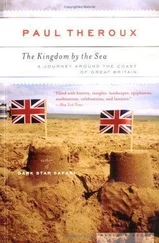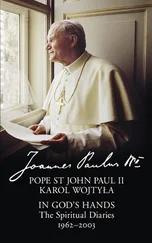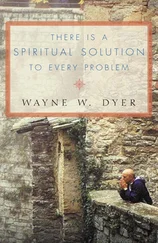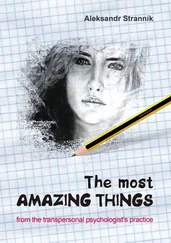Ejo said only one word in Spanish: Duele , “it hurts.” Then, bowing, he served the fish. We ate in silence. I began to understand that life goes on, that I must accept the pain instead of struggling against it or searching for consolation. When you eat, you eat. When you sleep, you sleep. When it hurts, it hurts. Beyond all that, there is the unity of the impersonal life. Our ashes must merge with the ashes of the world.
Then it occurred to me to ask him what was in the boxes.
“My belongings,” he answered. “They’ve loaned me this house. They might ask me to move out any day. Here, I’m feeling good. So why shouldn’t I feel just as good somewhere else?”
“But Ejo, this space is so small. Where do you meditate?”
He shrugged indifferently and casually gestured toward a corner. He needed no special place to meditate. It was not the space that made meditation sacred; it was his meditation that made the space sacred. In any case, for this man who had cut through the mirage of opposites, the division between sacred and profane had no significance.
In the United States, in France, and in Japan I have had the good fortune of meeting a number of other roshis. I even met my master’s master, Mumon Yamada, *2a very small man with the energy of a lion and hands as delicate and groomed as those of a lady (the nails on his little finger were more than an inch long). Yet no one could ever take the place that Ejo had conquered in my heart.
I know little of his life. Born in Kobe in 1928, he began to practice Zen at the age of nine in the monastery of Horyuji, under the direction of Roshi Heikisoken, the head authority of the Rinzai school. Later, at Kamakura, he entered the Shofukuji Monastery founded in 1195 by Yosai, †3the first monk to bring Chinese Zen Buddhism to Japan. There, he became a disciple of Mumon Yamada of the Soto school. The life of these monks aspiring to enlightenment was very hard. Always living in groups, deprived of intimacy or privacy, they ate little and poorly, worked hard, and meditated constantly. Every act of daily life — from how they slept to how they defecated — adhered to a strict ritual: “A monk must sit with his back straight, keeping his legs covered by the corners of his robe, looking neither to the right nor to the left, never speaking with his neighbors, never scratching his intimate parts, making as little noise as possible when excreting and accomplishing the act quickly, because others are waiting their turn. . The monks of the Soto Monastery must sleep on their right side; no other position is permitted. The monks of the Rinzai school sleep on their back; no other position is permitted.”
After living in this way for thirty years, in 1967 Ejo Takata decided that the times were changing. It was useless to preserve a tradition by remaining closed up in a monastery. He decided to leave Shofukuji and encounter the world. His determination led him to embark for the United States, for he desired to know why so many hippies were interested in Zen. He was received with great honor in a modern monastery in California. A few days later, he fled this place with only his monk’s robes and twenty dollars in his pocket. He reached a major highway and began to hitchhike, communicating mostly with gestures, because he spoke little English. A truck carrying oranges picked him up. Ejo began to meditate on the odor of the fruit, with no idea where he was going. He fell asleep. When he woke up, he found himself in the immense city that is the capital of Mexico.
By a coincidence that I would qualify as a miracle, he was seen wandering in the streets of this city of more than twenty million people by a man who was a disciple of Eric Fromm, the famous psychiatrist who had recently collaborated with D. T. Suzuki to publish a book called Psychoanalysis and Zen Buddhism . This man was so astounded that he could not believe his eyes: a real Japanese monk, robes and all! He stopped his car, invited the monk to get in, and ferried him off as a treasure to be presented to his students in Mexico City.
Maintaining a jealous secrecy regarding Ejo’s presence, the group set him up in a small house in the suburbs, which was transformed into a temple. Some months later, Ejo learned that before meditating, these psychiatrists took pills to help them endure with a beatific smile the hours of rigorous immobility. He thereupon bid them farewell and never returned.
By a series of coincidences (which I have described in La Danse de la Réalité ), I had the chance to meet this master. Seeing that he was homeless, I offered him my house, inviting him to transform it into a zendo. There, the monk found his first honest students: actors, painters, university students, martial arts practitioners, poets, and so forth. They were all convinced that through meditation they would find enlightenment: the secret of eternal life that transcends that of the ephemeral flesh.
It was not long before we realized that Zen meditation was no game. To sit very still for hours, striving to empty our mind, enduring pains in our legs and back, and overwhelmed by boredom was a heroic undertaking.
One day, when we had all but lost hope in ever attaining mythic enlightenment, we heard the rumbling of a powerful motorcycle, which came to a screeching halt in front of the house. Then we heard the vigorous steps of someone walking up to our little meditation room. There entered a large young man with broad shoulders, muscular arms, and blond hair. He was dressed in red leather, and stopped in front of the master and addressed him insolently, with a thick American accent:
“You deserted our monastery because you think you’re so superior, with your slanted eyes! You think that truth needs a Japanese passport? Yet I, a ‘despicable Westerner,’ have solved all the koans, and I’m here to prove it. Question me!”
We disciples were frozen in place, as if we were in a cowboy film in which one gunslinger challenges another to see who has the fastest draw.
Ejo, however, was unperturbed: “I accept!” he said.
And then a scene began to unfold that had us gaping in wonder. For me, as for the others, koans were unsolvable mysteries. Whenever we read them in books, we understood absolutely nothing. We knew that in Japan, monks sometimes meditated on these riddles for years or decades — questions such as “What is Buddha nature?” and answers such as “the cypress tree in the garden” had led us to despair ever understanding them. Zen does not seek philosophical explanations, but rather demands immediate understanding beyond words. “The cypress tree in the garden” left us disconcerted, revealing that we understood nothing, because we were not enlightened.
On one occasion, when I confessed my perplexity to Ejo, he replied brusquely: “Intellectual, learn to die!” This is why it was such a deep shock to see this aggressive, disrespectful, arrogant young man reply rapidly, with no hesitation, to the master’s questions.
Ejo clapped his hands. “That is the sound of two hands clapping. What is the sound of one hand clapping?”
The young man sat down with crossed legs, straightened his back, and raised his right arm wordlessly with his palm open.
“Good,” Ejo said. “Now, if you can hear the sound of one hand, prove it.”
Still silent, the youth repeated the gesture.
“Good,” Ejo said again.
My heart was pounding like a drum. I realized that I was witnessing something extraordinary. Only once before had I felt this peculiar kind of intensity: when I saw the great bullfighter El Cordobés decide to provoke the bull by freezing like a statue. The animal charged several times, his horns passing within a fraction of an inch of the man’s body, yet he was never gored. A strange vortex of energy seemed to envelop both man and beast, plunging them into an enchanted space-time, a “place” where error was impossible.
Читать дальше
